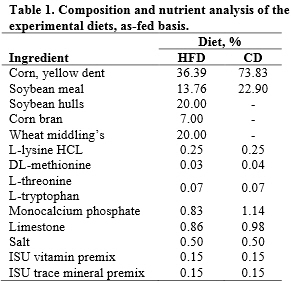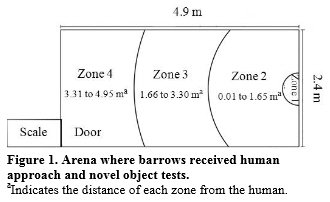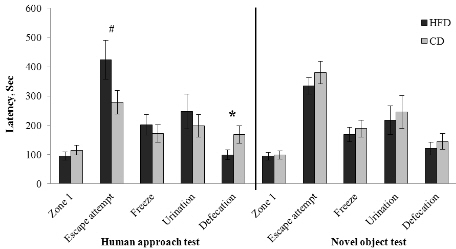



Barrow Behavioural Responsiveness to a Human or Novel Object When Fed Low- Versus High-energy Diets
A high-fibre, low-energy diet reduced overall pig activity in this study at Iowas State University and the researchers there concluded that this appears to modify fear responsiveness while undergoing human approach and novel object tests.Summary and Implications
The objective of this study was to determine if diet influences behavioural responsiveness to novel stimuli as assessed by human approach (HAT) and novel object tests (NOT).
Eighty Yorkshire barrows were fed a high-fibre, low-energy diet or a low-fibre, high-energy diet. Testing occurred over four consecutive weeks between 13:00 and 17:00h. Barrows were tested individually within a 4.9×2.4 metre test arena.
Throughout the test, zone activity, escape attempts, freezing, urination and defecation behaviours were recorded.
The results suggest that dietary fibre reduces overall activity and may modify fear responsiveness while undergoing human approach and novel object tests in swine.
Introduction
Low-energy, high-fibre diets are becoming more prevalent in the US swine industry due to the increasing price of high-energy, corn-soybean diets.
Previous work has reported that increased dietary fibre results in reduced physical activity in pigs. However, little is known about how diets high in fibre contribute to behavioral responsiveness in grow-finisher pigs, particularly while undergoing a stressful situation such as human approach (HAT) and novel object tests (NOT).
During these two tests, pigs are isolated from pen-mates and are placed into an unfamiliar situation, which may be perceived by the pig as threatening. These tests are often used to quantify an animal’s behavioural response to a novel stimulus.
Therefore, the objective of this study was to determine if diet influences behavioral responsiveness during HAT and NOT.
Such research can further our understanding of how dietary fibre may influence pig behaviour.
Materials and Methods
The protocol for this experiment was approved by the Iowa State University Institutional Animal Care and Use Committee.
Housing
This work was conducted at the Lauren Christian Swine Research Center at the Iowa State University (ISU) Bilsland Memorial Farm, near Madrid, Iowa.
All barrows were housed in groups (15 to 16 per pen) and each pen contained one Osborne Fire Feeder (FIRE®, Osborne Industries, Inc., Osborne, Kansas) positioned at the front of the pen.
Experimental design
The experiment was conducted from October to November 2011.
Eighty Yorkshire barrows (46.5±8.6kg) from the ISU Residual Feed Intake (RFI) selection project were tested, half of the pigs were low-RFI and half of the pigs were high-RFI.
The low- and high-RFI pigs were equally allocated to two treatments: high-fibre, low-energy diet (HFD; n=40) and a control, low-fibre, high-energy diet (CD; n=40, Table 1).

Forty barrows (n=20, HFD; n=20, CD) were randomised to the HAT first and the remaining 40 barrows (n=20, HFD; n=20 CD) experienced the NOT first. Upon completion of this cycle, barrows then experienced the opposite test one week later, creating a crossover experimental design. Testing occurred over four consecutive weeks between 13:00 and 17:00h.
Diet was blocked by time; therefore, within each testing hour, two HFD and two CD barrows were tested in random order.
Barrows were tested in the same order for both tests at the same time of day. The pen of pigs was the experimental unit and the individual pig was the observational unit
Human approach and novel object tests
Barrows were tested individually within a 4.9×2.4 metre test arena. Arena sides were lined with black corrugated plastic 1.2 metres high. The arena floor was divided into four zones (Figure 1).

Three colour cameras (Panasonic, Model WV-CP-484 Matsushita Co. Ltd., Kadoma, Japan) were placed above the test arena for video collection. Video was collected onto a computer using HandyAVI (HandyAVI version 4.3 D, Anderson’s AZcendant Software, Tempe, AZ) at 10 frames per second.
One observer collected live observations throughout the testing. During HAT, the human observer was located in zone 1. During NOT the observer was located behind zone 4, outside the test arena, with corrugated black plastic blocking the pig’s view of the observer.
During both tests, barrows were individually moved from their home pen to the test arena, which was located in a different room within the same building. Each barrow was weighed and allowed to habituate for one minute on a weigh-scale.
Following the habituation, the weigh scale door was opened into the back corner of the test arena and each barrow was tested for 10 minutes.
Measures
Continuous observation of video was done by one experienced observer using Observer software (The Observer XT version 10.5, Noldus Information Technology, Wageningen, The Netherlands). Behaviours scored from the video included zone 1 touches, total zone line crossings, escape attempts and freezing.
Urinations and defecations were collected through live observations (Table 2).
| Table 2. Definitions for collected behaviours. Latency (s) and/or frequency (n) of behaviours were collected |
|
| Behaviour | Definition |
|---|---|
| Zone 1 (s, n) | The mouth, nose, and/or face of the barrow touch any part of zone 1 |
| Zone crossing (n) | Total number of times zone 2, 3 and 4 lines crossed, defined as the base of both ears of the barrow crossing each line |
| Escape attempt (s, n) | Either both front legs or all four legs of the barrow off the arena floor in attempts to remove itself from the test arena |
| Freeze (s, n) | No movement of any portion of the barrow’s body was visible for >3 sec |
| Urination (s, n) | Excreting urine |
| Defecation (s, n) | Excreting faces |
Statistical analysis
All data were evaluated for normality before analysis using a Univariate procedure of SAS (SAS Institute Inc., Cary, NC).
Since data were not normally distributed, data were analysed using the Glimmix procedure of SAS. Latency data were analysed with a gamma distribution and frequency data were analysed with a poisson distribution.
The fixed effects included in the models were diet (HFD and CD) and previous experience within the arena, while bodyweight was used as a covariate. The significance level was fixed at P≤0.05.
Results and Discussion
Latency
During HAT, HFD barrows tended to take longer to engage in their first escape attempt (P=0.06); however, HDF barrows took less time for first defecation than CD barrows (P=0.03).
No differences were observed between diets for any other latency measures during HAT or NOT (Figure 2).

during the human approach and novel object tests.
* indicates difference (P=0.03) and # indicates tendency for difference (P=0.06).
Frequency
During HAT, HFD barrows tended to urinate fewer times (P=0.09); however, they defecated more times than CD barrows (P=0.03).
During NOT, HFD barrows crossed fewer zones than CD barrows (P<0.01). Additionally, HFD barrows engaged in more escape attempts (P=0.03) and tended to freeze and defecate more times than CD barrows during NOT (P=0.07).
No differences were observed between diets for any other frequency measure during HAT or NOT (Table 3). Differences in defecations are likely due to the high fibre content, resulting in more waste excretion.
| Table 3. Frequency (least square means ± SE) or total number of times behaviours are performed during the human approach and novel object tests |
||||||
| Human approach test | Novel object | |||||
|---|---|---|---|---|---|---|
| Measures, total number | Diet | Diet | ||||
| HFD | CD | P-value | HFD | CD | P-value | |
| Zone 1 | 6.78 ± 0.43 | 7.15 ± 0.44 | 0.56 | 7.41 ± 0.45 | 8.16 ± 0.47 | 0.26 |
| Zone crossing | 44.78 ± 1.10 | 44.48 ± 1.10 | 0.85 | 40.53 ± 1.04 | 47.96 ± 1.13 | <0.01 |
| Escape attempt | 0.84 ± 0.15 | 1.06 ± 0.17 | 0.36 | 1.19 ± 0.18 | 0.68 ± 0.13 | 0.03 |
| Freeze | 6.46 ± 0.41 | 7.01 ± 0.43 | 0.36 | 6.93 ± 0.43 | 5.82 ± 0.39 | 0.07 |
| Urination | 0.35 ± 0.09 | 0.63 ± 0.13 | 0.09 | 0.53 ± 0.12 | 0.56 ± 0.12 | 0.86 |
| Defecation | 4.66 ± 0.36 | 3.59 ± 0.31 | 0.03 | 4.29 ± 0.34 | 3.44 ± 0.30 | 0.07 |
Fewer zone crossings and increased freezing during NOT may be expressions of reduced activity of HFD barrows, explained through the lower dietary energy and composition differences of the HFD.
A diet high in fibre may result in reduced overall barrow activity in response to novel stimuli; which could be beneficial for feed efficiency by reducing energy expenditure.
In turn, the increased number of escape attempts and freezing expressed by the HFD barrows during the NOT may be expressions of fear.
As HFD and CD barrows did not differ in escape attempts and freezing during the HAT, further investigation should be done to determine if pigs fed a diet high in fibre are more fearful of novel stimuli.
The authors of this paper - published in Iowa State University Animal Industry Report 2014 - were Jessica Colpoys (Graduate Research Assistant), Anna Johnson (Associate Professor), Nicholas Gabler (Assistant Professor), Aileen Keating (Assistant Professor, Department of Animal Science, Iowa State University), Suzanne Millman (Associate Professor, Department of Veterinary Diagnostics and Production Animal Medicine, Iowa State University College of Veterinary Medicine) and Janice Siegford (Assistant Professor, Department of Animal Science, Michigan State University).
Acknowledgements: This project was supported by Agriculture and Food Research Initiative Competitive Grant no. 2011-68004-30336 from the USDA National Institute of Food and Agriculture.The authors thank Dana van Sambeek, Shawna Weimer, and Monique Pairis-Garcia for assistance in data collection.
Further Reading
You can see other papers in the Iowa State University Animal Industry Reports 2014 by clicking here.
April 2014








